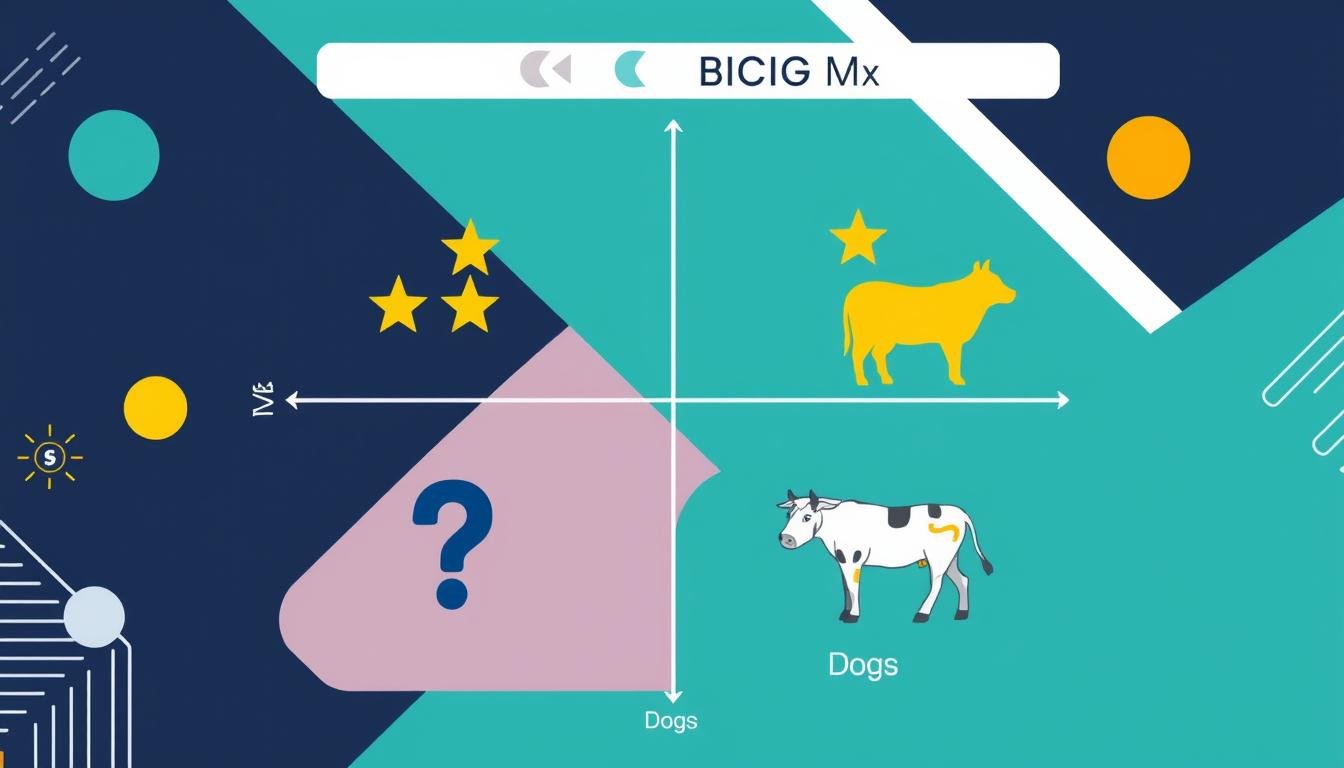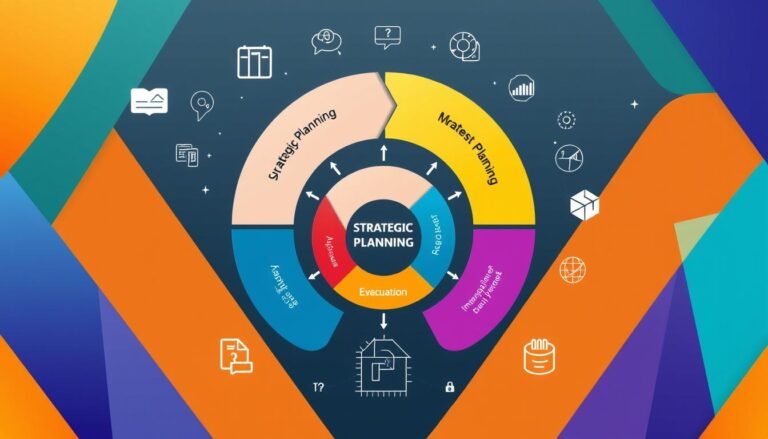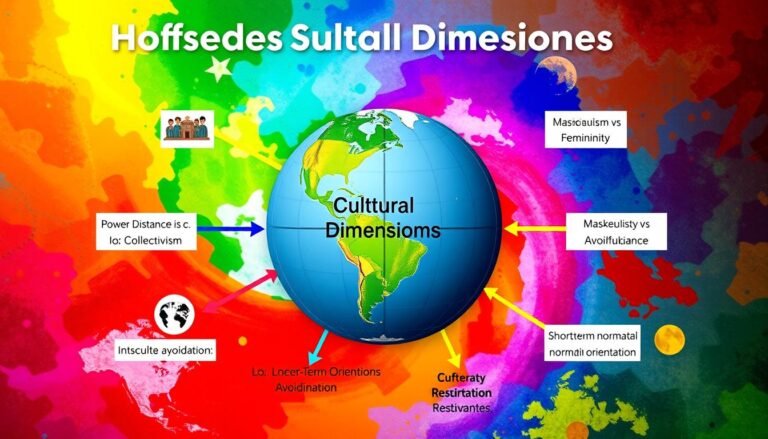BCG Matrix: Analyze Your Product Portfolio
Do businesses often miss out on tools that could change their growth plans? The BCG Matrix, also known as the Growth-Share Matrix, is a key tool for rethinking product portfolios. Created by the Boston Consulting Group in the 1970s, it sorts products into four main groups: Stars, Cash Cows, Question Marks, and Dogs. By looking at market growth and market share, the BCG Matrix helps companies make smart investment choices. This leads to better use of resources and higher profits.
Key Takeaways
- The BCG Matrix puts products into four groups based on market growth and market share.
- Knowing the differences between Stars, Cash Cows, Question Marks, and Dogs helps with planning.
- Checking the BCG Matrix often helps businesses adjust to market changes and spot new chances.
- Cash Cows are key for making money that supports investments in Stars.
- Question Marks need a close look to see if they can grow and make money.
- Using the BCG Matrix in digital marketing strategies improves how products are managed and placed.
- Even though it’s simple, companies must think about outside factors that could affect product success.
Understanding the BCG Matrix
The BCG Matrix is a key tool for businesses looking to understand their product portfolio. It puts products into four main groups based on market share and growth rate. The model shows how competitive a product is and its growth potential.
This helps with strategic planning. Companies can see their products and decide where to grow. It’s a way to focus efforts for the best results.
What is the BCG Matrix?
Products are sorted into four types: Stars, Cash Cows, Question Marks, and Dogs. Knowing these types is key for portfolio analysis. Stars are top products with lots of market share and growth. They need a lot of investment to stay ahead.
Cash Cows have a big market share but grow slowly. They make a lot of money with little investment. Question Marks are new products with growth potential but a small market share. They need careful thought before investing more.
Dogs are products in a slow-growing market with a small market share. Companies must decide if they’re worth keeping or not.
Importance of the BCG Matrix in Strategic Planning
The BCG Matrix helps show a company’s product lineup. It guides in deciding where to use resources best. This way, promising products get the focus they need, and weak ones are looked at closely.
But, the BCG Matrix has its limits. It doesn’t show how the market changes and focuses too much on market share and growth. Companies must think about these things for good strategic planning and making long-term choices.
Four Quadrants of the BCG Matrix
The BCG Matrix has four key quadrants for classifying products in a company’s portfolio. These quadrants help businesses decide where to put their resources for growth. Let’s dive into each quadrant’s role.
Stars: High Growth, High Market Share
Stars are products that grow fast and have a big share of the market. They need ongoing investment to stay ahead. These products can make a lot of money, boosting the company’s overall success.
Keeping an eye on Stars helps them stay competitive.
Cash Cows: Low Growth, High Market Share
Cash Cows are products in slow-growing markets but still lead the pack. They make steady money, which can be used to help other areas of the business. These products are key for keeping a company financially stable and supporting new products.
Question Marks: High Growth, Low Market Share
Question Marks are in fast-growing markets but don’t yet have a big market share. They need a lot of attention and investment to see if they’ll do well. Deciding what to do with them is a big strategic choice.
They can be risky, so they’re closely watched in the BCG Matrix.
Dogs: Low Growth, Low Market Share
Dogs have slow growth and a small market share. They usually don’t make enough money to keep investing in them. Companies must think hard about whether to keep or drop these products.
Knowing about Dogs helps manage risks from investing in losing products.
| Quadrant | Growth Rate | Market Share | Investment Strategy |
|---|---|---|---|
| Stars | High | High | Continual Investment Required |
| Cash Cows | Low | High | Generate Cash Flow for Reinvestment |
| Question Marks | High | Low | Significant Investment Needed |
| Dogs | Low | Low | Consider Phasing Out |
How to Use the BCG Matrix for Strategic Planning
Using the BCG Matrix strategy needs a step-by-step plan. Companies can improve how they place products and use resources by following certain steps. This method helps understand the market now and plan for the future.
Steps to Analyze Your Product Portfolio
First, identify the products or business units you want to look at. It’s key to know the competitive landscape well. Then, compare your sales with top competitors to find your market share.
Look at the sales over time to see how the market is growing. With all the data, you can plot your products in the BCG Matrix. This shows where each product stands in the market, helping guide your future plans.
Defining Market Growth Rate and Market Share
The market growth rate shows how sales or revenue in a sector change over time. It helps spot markets with big potential. Market share shows what part of total sales a company gets.
Knowing these metrics is crucial for using the BCG Matrix. Companies should focus on Stars and Question Marks for growth. Cash Cows are good for steady cash flow. Dogs might be worth selling as they don’t add much to profits.
BCG Matrix (Growth-Share Matrix) Analysis Examples
The BCG Matrix offers deep insights into how well products perform and helps with strategic planning. Many companies use it to check their product lines. For example, Coca-Cola uses it to look at their products.
Real-World Application of the BCG Matrix
Using a BCG Matrix lets companies see where their products stand. They sort products into Stars, Cash Cows, Question Marks, and Dogs. This helps them decide where to invest and how to use their resources.
By looking at market share and growth rates, companies can make smart choices. They focus on areas that need attention.
Case Study: Coca-Cola’s Product Portfolio
Coca-Cola uses the BCG Matrix well. For example, Coca-Cola itself is seen as a Cash Cow. It makes steady money even though its market is not growing much.
Dasani is a Star because it has a big market share and is growing. Fanta is a Question Mark, needing more investment to do better in the market. Some products might be Dogs, meaning they should be stopped unless there’s a good reason to keep them.
Advantages and Limitations of the BCG Matrix
The BCG Matrix, created by Bruce Henderson in 1970, offers key benefits for businesses. It helps by sorting products into four groups: Stars, Cash Cows, Question Marks, and Dogs. This makes it easier for companies to see where to invest, based on market share and growth potential.
Benefits of Using the BCG Matrix in Business
The BCG Matrix has a simple design that lets companies quickly see how their products are doing. It clearly shows which products are doing well and which aren’t. This helps in managing money and making smart investment choices.
For example, Apple’s iPhone is a Star, showing it’s growing fast and has a big market share. This lets companies focus their efforts to stay ahead or grow even more. The Matrix also helps spot areas for growth and where to make more money.
Potential Drawbacks and Constraints
However, the BCG Matrix has its limits. It might not capture the full picture of a business, focusing too much on market share and growth. It doesn’t look at profitability or how well products work together.
Also, calling a product a “low” or “high” can be tricky and might not always be right. The Matrix doesn’t give clear advice on how to improve products. This can be a problem in markets that change a lot because of new trends or technology.
Source Links
- How to use the BCG Matrix | Smart Insights Digital Marketing
- Introduction to the BCG matrix
- Boston Consulting Group (BCG) Growth-Share Matrix – SM Insight
- Boston Consulting Group (BCG) Growth-Share Matrix
- Boston Consulting Group (BCG) Matrix
- What is the BCG Matrix? Explaining its Components and Quadrants
- BCG Matrix – Overview, Four Quadrants and Diagram
- How to Use a BCG Matrix
- Understanding the BCG Growth Share Matrix and How to Use It
- The BCG Matrix: An Essential Tool in Marketing Strategy
- Understanding the BCG Growth Share Matrix and How to Use It
- BCG Matrix: Examples and How to Use It | SafetyCulture
- BCG Matrix (2024): Meaning and Example [+ Template]
- What is a BCG matrix? Example, Advantages, Limitations
- What are the advantages and disadvantages of using the BCG matrix to analyze your product portfolio?







